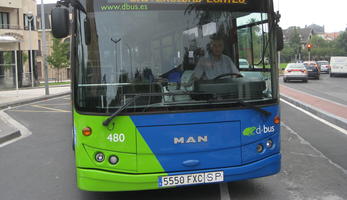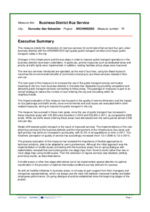New business district bus service
Basic Information
Mobility solution ID
17
Timeline
- complete
Project
Summary
In a situation that is quite common in European cities, before CIVITAS the business districts of Donostia-San Sebastian were poorly served by public transport. Private cars were the preferred mode and this was encouraged by the availability of large free car parks. In this measure, the city seek to make bus services more convenient for potential public transport users, by increasing frequency and introducing an adapted timetable.
Implementing sustainable mobility
The purpose of the measure was to meet the needs of commuters (whose mobility behaviour is mostly based on the private car) and encourage an increased use of public transport to access business districts in the city, by building an optimized and user-friendly environment for public transport modes in those areas. The bus service is operated with bio-diesel to maximize the environmental benefits of commuters choosing public transport instead of their private cars.
Progress
During the design phase of the measure, new bus services and new timetables were developed for better public transport accessibility to four business districts. One of the users’ needs, expressed by the managers in the business areas, was to have direct bus lines with a maximum of one interchange between buses during the commute. As a result of this, the bus company decided to first offer an increased service of direct bus lines from the centre and residential areas, instead of shuttle mini buses for the last mile. During the project life the following improvements were implemented for the public transport towards business districts:
- Zuatzu: on weekdays, every 20 minutes in peak hours and every 60 minutes the rest of the day (line 5), from Town Centre and Antiguo.
- Belartza: on weekdays, services every 40 minutes (line 25), from Town Centre and Antiguo.
- Miramon: on weekdays, services every 20 minutes (line 28) from Town Centre and Amara, and every 30 minutes (line 31) from Gros and Aiete, and every 60 minutes (line 35) from Antiguo and Aiete.
- Poligono 27: on weekdays, 5 services per day on peak hours (line 26) from Town Centre, Amara and Loiola.
The city realized the necessary changes in the infrastructure and bus stops in order to improve public transport operations in the business districts. In particular, priority measures such as dedicated lanes and priority at traffic lights were implemented (4 out of the additional 5 km of bus lanes implemented within CIVITAS affect routes that connect to business districts, while all 80 priority measures in traffic lights affect those lines). In addition, waiting facilities at bus stops in business districts were improved.
Outcomes
The measure has succeeded in reaching its main goals, since the use of public transport to access the business districts increased with 123.000 extra travellers in 2010 and 230.500 in 2011, as compared to 2006 levels. At the same time car traffic levels entering these areas decreased with almost 2.500 cars per day. The modal shift towards public transport was the result of improved services. The implementations of the new direct bus services to the business districts and the improvement of the infrastructure (bus lanes and light priority) led to an increased in punctuality, with 97,2% of all expeditions on time in 2011. The travellers’ perception of quality of service increased accordingly (from 7,0 in 2006 to 7,6 in 2011).








